Azza 633X-AD DDR
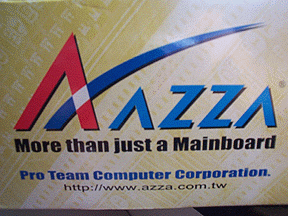
If you recall our review of the MSI K7T Turbo, we had a long discussion about who the biggest mainboard manufacturers are. Without reiterating ourselves too much, we can conclude that the list hasn't changed much. In fact, the first four are still the first four (ASUS, MSI, Gigabyte, ECS/Elitegroup), only their order is different. Obviously, Pro Team Computer Corp. is not in this "top list", but that doesn't change anything from our point of view. We have received their deluxe board for testing, we have tested it and...
Hirdetés
... and were awed by the results. Not necessarily talking about pure performance here, though. What we are talking about is the whole story of the board, the whole package, our friends at Pro Team and all the rest. Although Pro Team is not the biggest by all means, they are the owners of the Azza brand (which in turn means they produce all Azza boards... in fact, you can reach their renewed site at www.azza.com.tw, which is well worth a look, especially because of the beautiful blonde woman on the logo :). There is a vote going on currently about dismissing her... vote to save her! :)). Azza boards are known for their feature rich package, decent design and great price and our victim, the Azza 633X-AD doesn't wander an inch off the path of its predecessors. But what board are we talking? Enter the 633X-AD!

The 633X-AD is based on VIA's Apollo Pro266 DDR chipset, supporting Pentium III and Celeron FC-PGA processors. The board supports DDR SDRAM memory, 1.5GB of it at the maximum. The board also boasts an on-board Dolby Digital 5.1 sound-chip, which is non-standard by all means. Actually, this is the reason why we were really interested in this board and contacted Azza (Pro Team) for a sample. The funny thing is, that in the end, this feature became one of the least compelling compared to others, but more on this later... the Azza 633X-AD offers the whole spectrum of overclocking features: you can set any FSB in 1MHz increments (from 66MHz to infinity, meaning 166MHz), alter the core voltage of the CPU (-0.2V to +0.4V, which is quite a wide range actually... using a new, cC0 stepping Celeron/Pentium III, the highest possible voltage this way is 2.1V, which is a LOT) and alter the multiplier (which really has no use, as all Intel production processors are multiplier locked since ages).

So, with a full-blown DDR setup and all these tweaking features, we really shouldn't be asking for more, right? Wrong! If you think you have seen a big mainboard package, you are also wrong! Azza calls the package the "Jumbo pack" and they have every reason to do so, as it is HUGE! Inside is Azza's Azza-UP front panel with USB and audio connections fitting into a single, 5.25 inch drive bay. Inside is the most current version of Mandrake Linux and StarOffice. Inside is VirtualDrive, a CD-ROM caching program (copying the contents of the CD to the HDD and creating a virtual CD-ROM drive to access it... as the HDD is at least 10 times faster than any CD-ROM, this could be a useful feature for frequent CD-ROM users). At last, but not least, inside is our board:
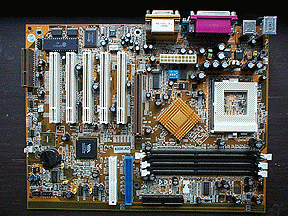
One of the first things that could draw attention is the set of DIP switches on the board. Yep, the 633X-AD is not fully jumperless (well, it is, but not dipswitchless :)). Some people disprefer solutions like this, while we were actually pleased. Why? If you overclock your CPU to an extent where you end up being unable to boot (this always happens when you are trying to find the absolute maximum of a given CPU and do not have three weeks to test MHz by MHz), you don't have to clear the CMOS deleting all your settings (and in case of this board, there are quite a few of them!), only change a few jumpers/DIP switches, reboot, reenter Setup and roll... the switches are used to alter the default FSB, available options are Auto, 66MHz, 100MHz and 133MHz. You can always overclock some more by entering Setup and adding any positive number (between 0-32MHz) to the selected default FSB speed.
Pro266, DDR and some theory
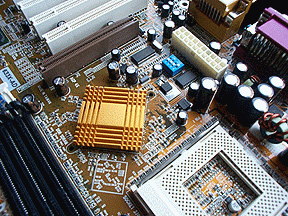
Before diving deeper into the specifications and features, let's examine VIA's "newcomer", the Apollo Pro266 chipset driving our board. The term DDR is commonly accepted today as the way to high-performance and therefore is also constantly used as a marketing term. DDR is good, but is not enough alone. As you probably all know by now (thanks to nVidia, then AMD), DDR stands for Double-Data Rate and is a method of supplying double the amount of data in the same time. More precisely, a RAM chip using the DDR technique (DDR SDRAMs) is transferring information on both the rising and the falling edges of the clock signal, while conventional RAMs (SDR, Single-Data Rate) do this only on the rising edge (or only on the falling, depending on the signal type used in the given system). Therefore, DDR SDRAMs are theoretically two times as fast as SDR SDRAMs. We are saying theoretically, because other factors are also vital in a full system's performance (not talking about the video subsystem yet). The most important being the Front Side Bus (FSB) speed and width. The width is the easier case, as it is 64 bits (8 bytes) for current desktop systems. The speed, however, greatly differs and this does effect performance as well. If you recall, AMD has been using the Alpha's (Digital's, then Compaq's, now Intel's) EV6 bus protocol, which send data through the main bus in a DDR fashion. Therefore, at a 133MHz DDR FSB, EV6 is sending data equivalent of a 266MHz (traditional) FSB. This is a perfect match for the 133MHz DDR memory, as the memory bus is also 64 bits wide and therefore the whole system is "Double Pumped", or DDR, or transfers two times as much data, whichever you prefer.
You can now see that AMD systems with SDR memory (those being all Slot A Athlons, and Socket A systems based on AMD-750, VIA KT133 and VIA KT133A chipsets) are bottlenecked by the memory interface: the main bus using EV6 is double-pumped, but the memory interface is not. Well, unfortunately for VIA and for this very board, the Pro266 chipset suffers from the same problem, albeit from the opposite direction: the memory is double-pumped (DDR), but the main bus is still only 133MHz single-data rate. This means that the Pro266 chipset is seriously bottlenecked by its FSB and most of the extra power in DDR RAM remains unused. Actually, having benchmarked quite a few systems (we are a hardware site, after all :)) we can safely say that the FSB is the main bottleneck in almost all systems today (save for the Pentium 4), as the main bus must supply the memory subsystem, the AGP bus, the PCI bus, etc. with data. Overclocking your processor via FSB is always a beneficial thing as besides extra CPU speed, you also gain extra FSB bandwidth. And while in theory DDR AMD platforms are very well balanced, once we move to real-world benchmarks (but even is synthetic benchmarks) we see that by changing the memory inferface from SDR to DDR (such as a move from the VIA KT133A platform to the KT266), we do NOT gain a 100% speed improvement. To put it another way, SDR memory was not withholding the DDR main bus completely.
Why is this important? Because all this means that raising the FSB in a system yields more performance, while raising the memory speed alone results in less gains. As the VIA Pro266 does the latter, we shouldn't be surprised of lower benchmark results. It is mainly because of this that the Intel based platform performs below the equivalent AMD system and not because the Athlon can take advantage of higher bandwidth and the Pentium III can't (like many sites stated). Sure, the Athlon CAN take advantage, but not because of the CPU being superior (it is superior, but that alone wouldn't be enough), but because of the EV6's HIGHER MAIN BUS BANDWIDTH. And if you look at the bandwidth figures of Intel's next-gen system (talking P4 here), you can see that this issue has been dealt with in a major way (while other problems were introduced... but FSB and memory throughput are equal(ly high) at 3.2GB!).
OK, enough of the boring theories, let's get to the real stuff!
Specifications and afterthoughts
| Azza 633X-AD | |
| Supported CPUs | Intel Pentium III (up to 1GHz)/ Celeron FC-PGA (up to 900MHz+) |
| CPU socket | Socket-370 (PPGA/FC-PGA) |
| System bus | 66/100/133MHz SDR |
| Chipset | VIA Apollo Pro266 |
| Supported FSBs | 66-166MHz |
| Overclocking features |
|
| Memory | Three 184 pin DIMM slots supporting max. 1.5GB DDR SDRAM |
| Expansion slots (AGP/ PCI/ ISA/ AMR|CNR) | 1/5/0/1 |
| USB ports | 6 USB 1.1 |
| Integrated VGA | None |
| Integrated sound | AC'97 soft CODEC supporting Dolby Digital (AC-3) 5.1 decoding |
| Other features | Azza-UP front panel, Mandrake Linux, StarOffice, VirtualDrive |
| BIOS | Award BIOS v6.00.PG |
| Dimensions | ATX, 304x235mm |
| Related online material | "Azza.com", BIOS, manual (PDF) |
Now our usual comments on the chart: the first thing that we notice is that our long-awaited Dolby Digital sound-chip is not exactly what we were thinking about. To put it simple, it is software based and thus consumes the system's resources seriously, it does not offer a digital output (S/PDIF Out) and what's more it simply sounds horrible. It might be a nice thing for system integrators because they can include it on the checklist and it was definitely enough for us to get tricked into wanting this board, but all-in-all, you should not be looking into this feature unless you want your shiny new 1.33GHz Athlon to perform below the neighbour's 750MHz Duron when playing music. Luckily, this is about where the negative critics end, since apart from this little "nuissance", the board was simply superb.
Booting is FAST! I had to reset 4 times before I could hit F8 before the Windows boot. I simply wasn't fast enough :). The BIOS Setup is organized in a way we have never thought it was possible. ALL manufacturers could and should learn from Azza on this one. Everything is where it should be, information/settings are well divided into subsections and you are allowed to control everything if you dig deep enough. Apart from the booting process, Pro Team itself was also fast, as when we requested them for a new beta BIOS (we were having some awkward problems, but they later turned out to be unrelated to the board), they sent it as soon as there was one. Kind of a cool thing to flash the BIOS and see that its compilation date is TODAY :)). The new BIOS added the option of enabling the BIOS for the onboard LAN chip, which unfortunately didn't have its connector and thus couldn't be tested (onboard LAN, Sound and Modem are all functions of the VIA sets, with LAN and Modem integrated into the South-Bridge and a separate VIA chip driving the Sound). The RAM Timing settings also received 3 new options and what a wise decision that was! You will see from later benchmarks that tuning these three settings yielded a 10 percent memory boost, alone.
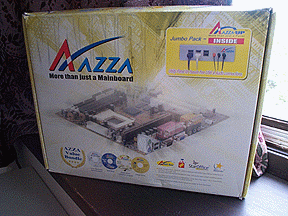
The board also has a little red light that only turns on, when the system has been shut down but is under power (+5V). Whenever you see the red light, don't touch the board! We assume that one can recognize a running system and thus do not need lights to show that the computer is on (just listen to the Earthquake-like shake/sound those FOP38's produce and you can't go wrong... :))). This is actually a feature of ATX which we aren't very fond of. It is useful for WOL (Wake-Up on LAN) and other automatic wake up methods, but is not really useful when you truly want to turn the system off. So, before installing your second AGP GeForce3 board into the 633X-AD :), make sure you pull the plug.
Stability: unarguably the most important feature of a motherboard. This was the biggest question we had in mind, but the 633X-AD didn't dissapoint, at all. It actually allowed us to run our Celeron 566MHz FC-PGA CPU a tad higher than what we could achieve with MSI's 815EP Pro-R. In the long run, both boards were rock stable at a 112MHz FSB (resulting in 8.5 x 113 = 952MHz... not bad for a 566MHz chip (1.7V, cC0 stepping)) and that puts the Azza board right on par with MSI's offering (MSI also has a Pro266 board, better said a lot of Pro266/Pro266T boards). Before we move on to our regular Sandra memory benchmarks, I would like to point out that the 633X-AD does not support Intel's freshly released Tualatin CPU (officially known as Pentium III-S) as it is based on the Pro266 and not the Pro266T chipset. But expect Azza to release such a board just like other manufacturers do.
Pro(266)Test
Test Setup:
- Azza 633X-AD mainboard (VIA Pro266)
- Intel Celeron FC-PGA 566MHz CPU at 952MHz (112MHz FSB)
- 128MB Samsung PC2100 CAS2.5 DDR SDRAM at CAS2 (112MHz FSB + 33%)
- Quantum Fireball Plus LM 20.5GB 7200RPM HDD
- Leadtek GeForce3, Gigabyte MX200 video cards
- Sound Blaster Live! sound card
- Nokia 447Xa 17" monitor
- Windows 98SE, DirectX 8.0, nVidia Detonator5 12.41, SiSoft Sandra 2001SE
Unfortunately for us, no matter how much we emphasized the importance of a higher FSB (especially on a truly FSB limited platform), all we had is an Intel Celeron 566MHz CPU to test with. We immediately forgot about testing at stock speed and overclocked as much as we could. This gave us a hefty FSB increase from 66MHz to 112MHz, but we were still far from where most P3 CPUs take off: 133MHz. Add to all this that the Celeron's L2 cache subsystem is severely crippled (not only the size, but latency and 8-way associativity was harmed) and we have a less than desirable platform. This also means that users with P3 processors using a high FSB can expect much higher results. Using the original shipping BIOS, with the above mentioned 3 additional RAM timig options set to the fastest values, using CAS-2 setting, 4-Way Interleaving and 112MHz + 33% asynchronous memory operation, we got the following results:
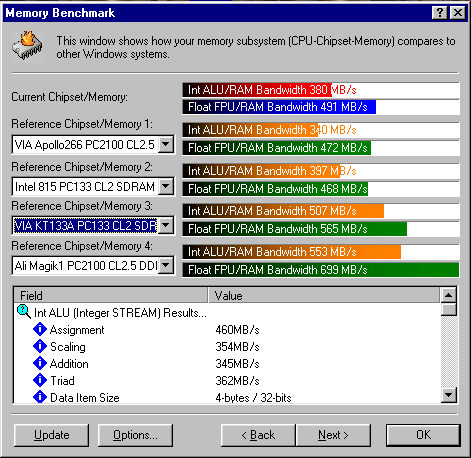
Not bad, not bad. The 633X-AD trumphed the reference Pro266 system by about 10% in average, although the reference system was using the slower CAS2.5 setting (but probably a P3 CPU and 133MHz FSB). If we raised the FSB to 118MHz, but forgot about the 3 new RAM timing settings, we got the exact same results (+/- 2 points). Now let's see what happens if we test at 118MHz with the old BIOS (everything is at max, except for the 3 new options: "118MHz noops") and with the new one (everything is at max, including the 3 new options: "118MHz max"). As "112MHz max" is equal to "118MHz noops", you can also use the following chart to compare "112MHz max" and "118MHz max", thus the influence of FSB speed.
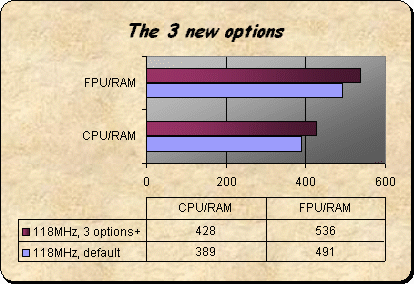
Wow! That's a 10 percent plus for that 6MHz FSB increase! Well, to be honest, not exactly, as the equality of "112MHz noops" and "118MHz max" shows that the extra gain due to the +6MHz FSB is tarnished with the lower RAM settings. Nevertheless, it is a safe guess that using eighter setting 'ceteris paribus' (fixing everything at a certain value and only changing one variable, the FSB in this case) the RAM scores would scale linearly with the FSB. It is also worth noting that while the Pro266 chipset is far from the memory performance of the AMD based systems, it is still far better than Intel's very own i815E/EP (SDR) and since Intel does not offer any higher-end chipset for the Pentium 3 (forget i820), users seeking the best platform for their Pentium 3 processor are right when they bet on VIA.
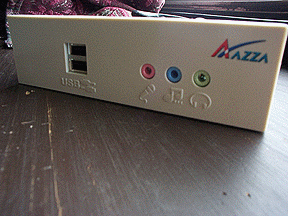
All things must end and our review is no exception. The time has come to sum our findings up, which - in this case - is a fairly easy task. Hindered by the slower FSB (Intel's GTL+ protocol, to be exact) the Pro266 chipset cannot keep up with the similar offerings for AMD's platforms. Nevertheless, it is still the best solution for performance hungry Pentium 3 users and Pro Team Computer has built a board around it that truly deserves our greatest respect. Coming with a jumbo box including the Azza-UP Front Panel for USB and audio connections, Mandrake Linux, StarOffice, VirtualDrive the board is more feature packed than almost anything else we have seen before (although there is a lot to see!). Add decent speed, 100% stability, the full spectrum of overclocking options, great design, a superb BIOS and a low-low price and you have it all! The Pro266 chipset is definitely something which needs serious improvement, but that is not Pro Team's job. Their job is to create the best possible board for each given chipset, and with the Pro266 based 633X-AD, they might have just succeeded. Surely there are other great boards out there, possibly even better, but the 633X-AD is simply well worth its money and we really can't ask more from a mainboard.
Due to all our positive findings we hereby award the 633X-AD with our PLUS A LOT Golden Award. Congratulations!

(Marton Balog, alias Parci)












